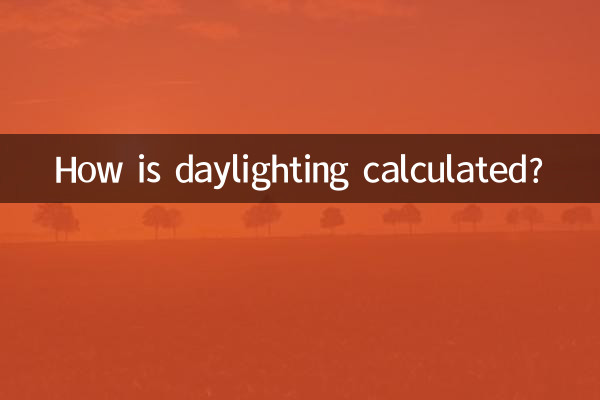How is daylighting calculated?
In architectural design and interior decoration, lighting is a crucial factor. Good lighting not only improves living comfort, but also saves energy. So, how is daylighting calculated? This article will combine the hot topics and hot content on the Internet in the past 10 days to provide you with a detailed analysis of the lighting calculation method and related data.
1. Basic principles of daylighting calculation

The core of daylighting calculations is to evaluate the degree of natural light entering the room. Usually, the daylight factor (DF) is an important indicator to measure the lighting effect. Daylighting coefficient is defined as the ratio of the illumination at a certain point indoors to the illumination on an unobstructed horizontal surface outdoors at the same time, usually expressed as a percentage.
| Lighting level | Daylighting coefficient (%) | Applicable scenarios |
|---|---|---|
| Excellent | ≥5% | Living rooms, study rooms and other areas that require high illumination |
| good | 3%-5% | Bedrooms, dining rooms and other general living areas |
| Average | 1%-3% | Secondary areas such as corridors and storage rooms |
2. Main factors affecting lighting
The lighting effect is affected by many factors. The following are the key factors mentioned in recent hot discussions:
| factors | degree of influence | solution |
|---|---|---|
| window area | high | Increase window area or use floor-to-ceiling windows |
| building orientation | high | Prefer south or southeast direction |
| Peripheral occlusion | in | Reduce obstruction by tall buildings or trees |
| Glass transmittance | in | Choose glass material with high light transmittance |
3. Specific methods for daylighting calculations
Daylighting calculations are usually divided into two methods: theoretical calculation and software simulation. The following are specific methods mentioned in recent hot topics:
1. Theoretical calculation method
The theoretical calculation method is mainly based on the daylighting coefficient formula:
DF = (Ei / Eo) × 100%
Among them, Ei is the illumination at a certain point indoors, and Eo is the illumination at an unobstructed horizontal plane outdoors. This method is suitable for simple scenarios, but the calculation process is cumbersome.
2. Software simulation method
With the development of technology, more and more designers use professional software (such as Dialux, Radiance, etc.) to perform lighting simulation. This method can display the lighting effect more intuitively and support the analysis of complex scenes.
| Software name | Applicable scenarios | Popularity |
|---|---|---|
| Dialux | Building lighting simulation | high |
| Radiance | High-precision daylighting analysis | in |
| Ecotect | sustainable building design | in |
4. Recent hot lighting topics
According to the data of the entire network in the past 10 days, the following are the hot discussion topics about lighting:
1. Green Building and Lighting Design
With the popularity of green buildings, how to reduce energy consumption through lighting design has become a hot topic. Many experts recommend integrating daylighting design with solar utilization to maximize energy use.
2. Lighting optimization for small apartments
In urban residences, the issue of lighting in small apartments has attracted much attention. Popular solutions include using mirror reflections, open layouts and light-colored finishes.
3. Intelligent lighting system
The rise of smart homes has driven the development of smart lighting systems. Through sensors and automatically adjusting curtains, the system can adjust indoor lighting in real time according to changes in light.
5. Summary
Daylighting calculation is an important link that cannot be ignored in architectural design and interior decoration. Through scientific calculation methods and reasonable design strategies, the comfort and energy efficiency of the living environment can be significantly improved. Hopefully this article has provided you with valuable information to help you better understand and apply daylighting calculations.

check the details

check the details